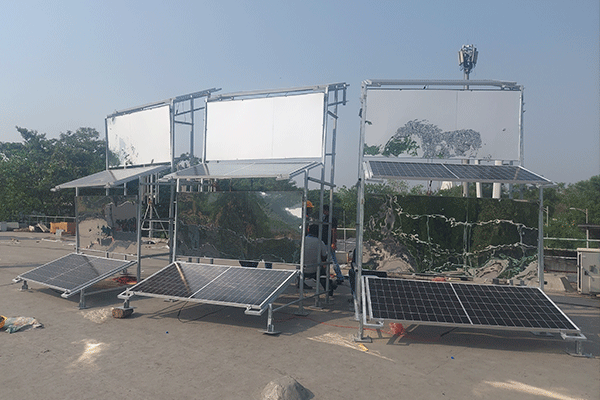How about solar PV systems that can be moved from one place to another to generate power? And what if the system also lets you generate more power than conventional setups while freeing up a good deal of space for other purposes?
Researchers at the Indian Institute of Technology Delhi (IIT Delhi) have developed portable solar towers that generate 20-30% more power while requiring only 50-60% rooftop space compared to conventional solutions. These solar towers are portable in that they can be mounted on a truck and taken anywhere to generate power. Use of mirrors alongside solar panels redirects the sunlight to the panels, maximizing the solar power generation.
These space-saving solar towers are designed in mechanical and non-mechanical tracking versions. Both the systems are patented by IIT Delhi and licensed to Banglore and Mumbai-based EP Sunsol for commercial installation. EP Sunsol has already deployed the systems of 3kW, 4kW and 5kW capacities at Chennai, IIT Delhi, and Navi Mumbai, respectively.
The systems are scalable to higher capacity with the addition of more arrays in a tower design and are particularly useful for electric vehicle charging stations, rooftop solar power generation, and power generation for agriculture purposes (agri-photovoltaics) such as solar water pumping, charging the battery for tractors, etc.
“After intensive research, we got success in arriving at the lightweight and cost-effective novel design on mounting solar PV towers along with high reflectivity mirrors to follow the Sun movement. Both non-mechanical and mechanical solar towers can generate 20-25% and 25-30% more power, respectively, while utilizing only 50-60% rooftop space compared to conventional solutions,” said Dalip Singh Mehta, a professor at the Physics Department of IIT Delhi, and part of the project team.
Mayank Gupta and Virendra Kumar (Department of Physics), Masood Ali (SeNSE), and Sanjay Ambwani (Design Department) were also part of the IIT Delhi research team. The EP Sunsol Team, which did the installation, comprised Mahadevan R and Hitesh Mehta.
In non-mechanical tracking solar tower, solar panels, along with high-reflectivity mirrors, are vertically mounted at an angle based on the location that these fall in the line-of-sight of Sun during the morning, mid-day and evening hours, hence leading to high-efficiency solar power generation.
“The mounting methodology helps to generate more power during non-peak hours of the Sun, i.e., 9am-11am and 2pm-5pm in addition to peak hours of 11pm-2pm. The mirrors/reflectors deployed in this solution boost the irradiance on solar panels during the entire day i.e., 8 am – 5 pm. The percentage of increase of solar irradiance onto the solar panels is more than 50%, thus maintaining 1000W/m2 from 9 am – 4 pm. Due to this increase in solar irradiance from 9 am – 4 pm, the increase in the amount of power generated is 20-25% compared to the conventional mounting of solar panels,” according to IIT researchers.
In the ‘mechanical tracking’ version, the solar PV tower with mirror reflectors employs a low-cost programmable electro-mechanical system for horizontal single-axis solar tracking rotation from east to west. Single/double towers are mounted in such a mechanism that the whole system with panels and reflectors follows the direction of the Sun. The panels start the day facing the East direction and end the day in the west direction. By the next morning, the panels return to their East facing position to start a new day.
The innovative tracking system developed by IIT Delhi does not require any light-dependent resistance (LDR) based sensors and consumes very low power drawn from the solar tower itself.
This content is protected by copyright and may not be reused. If you want to cooperate with us and would like to reuse some of our content, please contact: editors@pv-magazine.com.









When you mount the mirrors facing to the sky you can cool down the site with the power of the space and even harvest dew water. I have constructed one in Austria and lowered the temperature of the mirrored roof surface up to 50% compared to a dark roof surface.